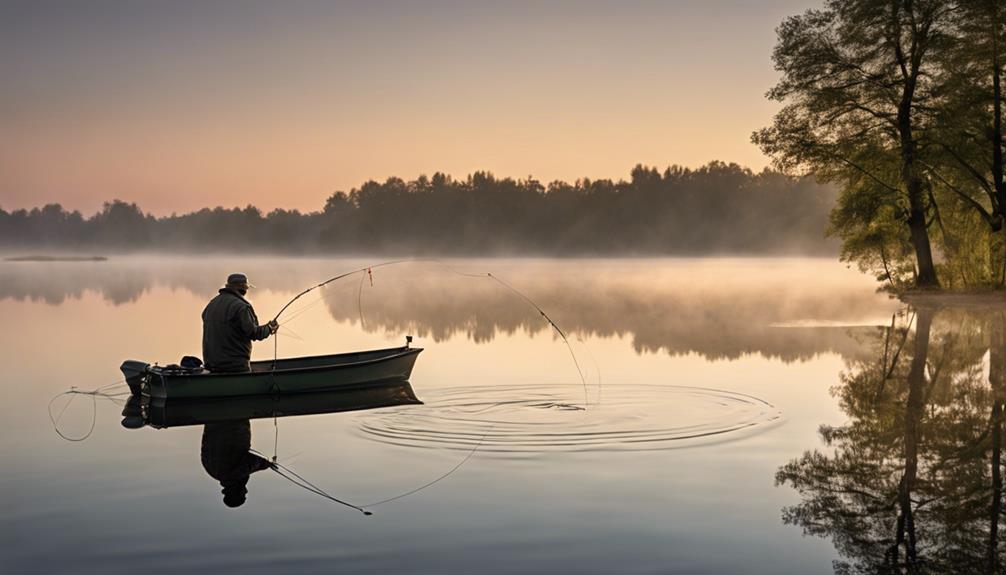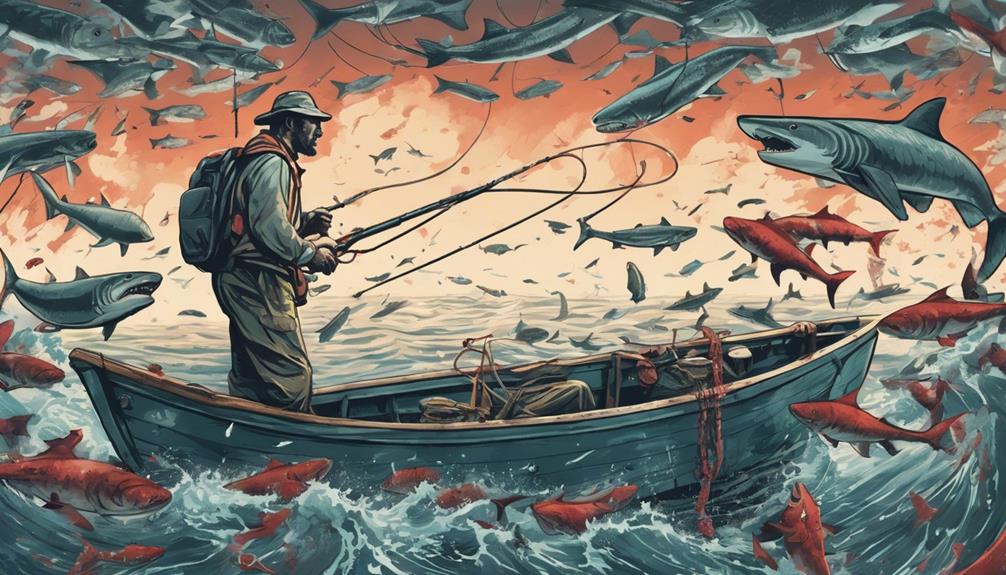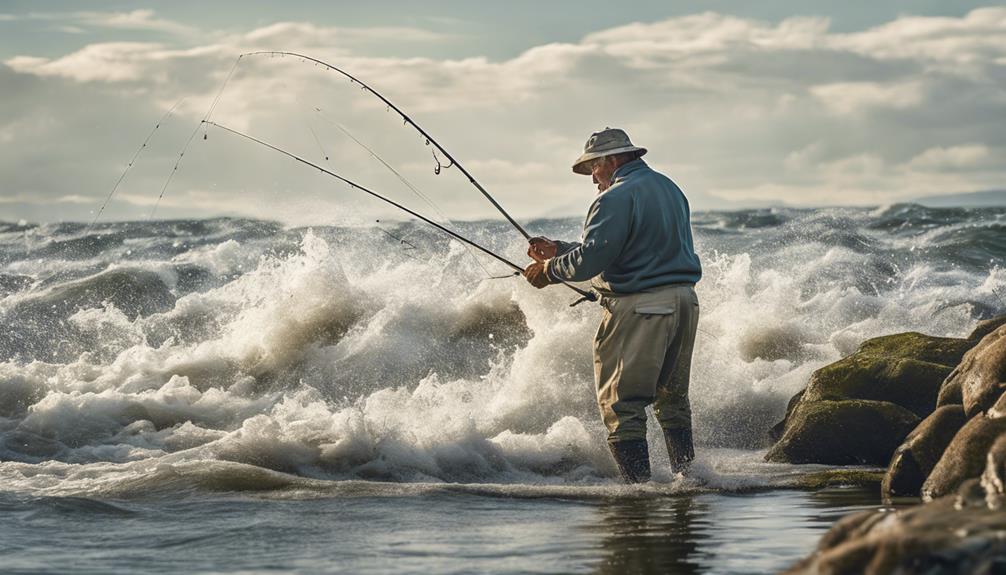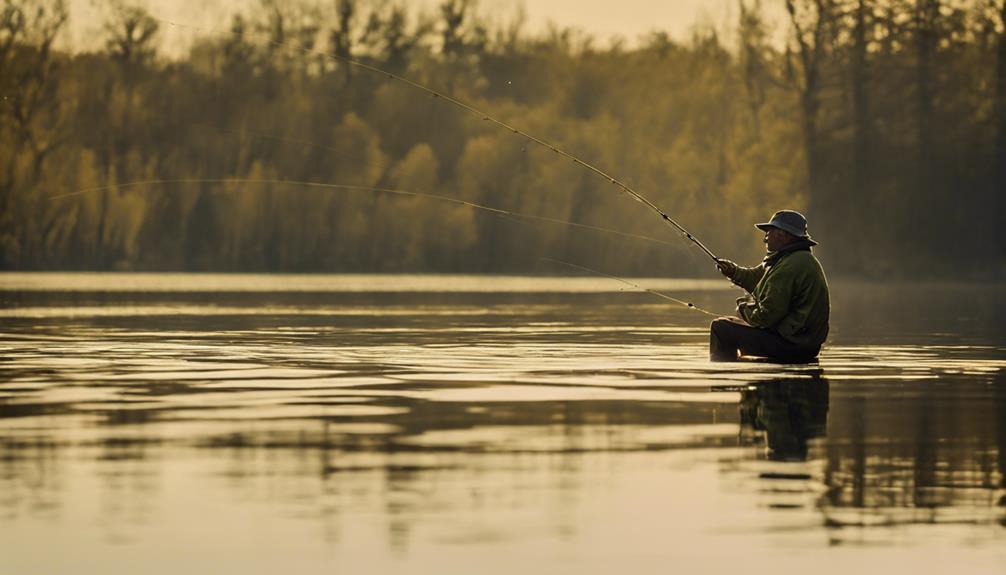When it comes to mastering the art of fishing during the spawning season, you need to have a few key techniques up your sleeve. From selecting the best baits to understanding fish behavior, there are strategies that can significantly up your game.
But what if we told you there are four techniques that stand out above the rest, ensuring you reel in those elusive trophy fish? Stay tuned as we unveil these essential tips to elevate your spawning season fishing experience.
Best Baits for Spawning Season
When targeting fish during spawning season, opt for natural baits like worms, minnows, or insect imitations. Live bait options such as minnows or worms are excellent choices to entice fish during this time. The lifelike movement of live bait can trigger aggressive strikes from protective spawning fish. Artificial lures designed to mimic insects can also be effective, fooling fish into striking out of instinct or territorial behavior.
Natural bait preferences often vary depending on the fish species and the specific conditions of the water body. For example, if targeting bass during spawning season, using plastic worms in natural colors like green pumpkin or watermelon red can be highly effective. These colors blend in well with the surroundings and appear more natural to the fish. For panfish like bluegill or crappie, live bait such as small minnows or insect imitations like crickets or grasshoppers can work wonders.
When selecting bait colors, consider the water clarity and light conditions. In clear water, natural colors that closely resemble real prey are usually more successful. However, in murky or stained water, brighter colors or lures with added flash can help attract fish by increasing visibility. Experiment with different bait colors and types to see what works best in the specific spawning season conditions you encounter.
Top Water Techniques
To master top water techniques for fishing during spawning season, focus on using surface lures that create enticing movements. When it comes to surface action, early morning is the perfect time to witness fish actively feeding near the top of the water.
To make the most of this prime time for fishing, follow these tips:
- Use topwater lures: Opt for lures like poppers, prop baits, or frogs that create commotion on the surface, imitating struggling prey and attracting nearby fish.
- Focus on accuracy: Cast your lure near cover such as lily pads, fallen trees, or rocky outcrops where fish are likely to hide and ambush their prey.
- Experiment with retrieval: Try different retrieval techniques like a steady retrieve, a stop-and-go motion, or walking the dog to see what entices the fish to strike.
During the early morning hours, fish are more active and willing to strike at surface lures. By presenting your bait in a natural and enticing manner, you increase your chances of tempting the fish to bite. Keep in mind that each fishing location and species may require slight adjustments, so be prepared to adapt your techniques accordingly.
Enjoy the thrill of watching a fish explode on your surface lure during spawning season.
Deep Water Strategies
As you shift your focus from surface fishing techniques to deep water strategies during spawning season, explore the effectiveness of targeting fish in their cooler, deeper hiding spots. Deep water tactics can be highly successful when trying to catch fish that have moved away from the shallows. During spawning season, many species seek out deeper waters for cooler temperatures and protection. To maximize your success with deep water strategies, consider the use of underwater structures as key locations for finding fish.
When employing deep water tactics, it's crucial to locate underwater structures such as rock formations, submerged trees, or drop-offs. These structures provide cover for fish and attract them to these areas. By targeting these underwater structures, you increase your chances of hooking a fish during spawning season. Using techniques like drop shot rigs, jigging, or deep diving crankbaits can help you reach the depths where the fish are hiding.
Pay attention to the water temperature and depth to determine where the fish are most likely to be located. Deep water strategies require patience and precision, as fish in these areas may be less active than those in shallower waters. By understanding the behavior of fish during spawning season and utilizing deep water tactics effectively, you can improve your chances of a successful fishing trip.
Targeting Bedding Fish
During spawning season, consider targeting bedding fish by focusing on their nesting areas for increased chances of catching them. When you target bedding fish, you need to understand their behavior and habitat to maximize your success. Here are some key tips to help you effectively catch bedding fish:
- Sight fishing: Approach the nesting areas quietly and look for fish cruising around or guarding their beds. Being able to spot the fish visually will significantly increase your chances of a successful catch.
- Understanding bedding patterns: Bedding fish tend to follow certain patterns depending on the species and the specific body of water. Learning these patterns can help you predict where the fish will be and how they'll behave, giving you an edge in your fishing endeavors.
- Patience and precision: Bedding fish can be easily spooked, so it's crucial to approach them with caution and make precise casts to avoid scaring them away. Take your time and be patient; a well-executed presentation can lead to a rewarding catch.
Effective Lure Selection
For optimal success in catching bedding fish during spawning season, the key to effective lure selection lies in understanding the fish's preferences and behavior in their nesting areas. When selecting lures for spawning season fishing, consider the lure presentation and water clarity to increase your chances of enticing the fish to bite.
Lure presentation is crucial when targeting bedding fish. Opt for lures that mimic the behavior of prey fish entering the nesting areas, such as soft plastic baits or jigs that can be worked slowly and methodically around the beds. These lures can trigger a protective or aggressive response from the nesting fish, leading to more strikes.
Additionally, take into account the water clarity when choosing your lures. In clear water conditions, natural-looking lures that closely resemble the fish's natural prey, like minnows or crawfish, tend to be more effective. On the other hand, in murky or stained water, brightly colored lures or those with rattles that create noise and vibrations can help attract the attention of the fish.
Understanding Fish Behavior
To understand fish behavior when targeting nesting fish during spawning season, observe their movements and reactions to different lures and presentations. Understanding how fish migrate and their feeding patterns can greatly enhance your chances of success. Here are some key points to keep in mind:
- Fish Migration: Fish may move to shallow waters during spawning season, making them more accessible to anglers. Pay attention to where the fish are moving and position yourself strategically to increase your chances of a successful catch.
- Feeding Patterns: During spawning season, fish may exhibit different feeding behaviors. Some species become more aggressive and territorial near their nests, while others may be more focused on protecting their eggs. Adjust your fishing techniques accordingly to entice bites from these fish.
- Reactions to Lures: Different fish species may react differently to various lures and presentations. Experiment with different types of lures, colors, and retrieval speeds to see what triggers a response from the fish. Observing how the fish react can help you fine-tune your approach for maximum effectiveness.
Tips for Catching Big Spawners
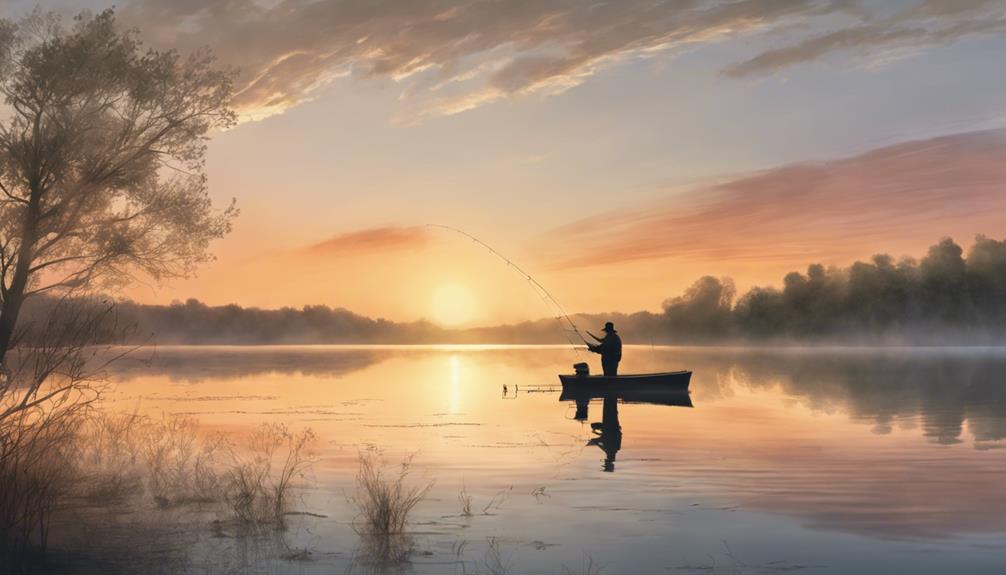
When targeting big spawners, positioning yourself strategically based on their movements can significantly increase your chances of a successful catch. During spring fishing, catching bass can be particularly rewarding if you focus on areas where big spawners are likely to gather. Look for shallow waters with a mix of rocks, logs, and vegetation, as these provide ideal spawning grounds for bass. Big spawners tend to seek out these areas to build their nests and protect their eggs, making them prime locations for a successful catch.
To maximize your chances of catching big spawners during spring fishing, it's essential to pay attention to their behavior patterns. These fish are typically more active during the spawning season, making them more likely to strike at bait or lures. Try using brightly colored lures or live bait to attract their attention and provoke a strike. Additionally, consider the timing of your fishing trips – early mornings and late evenings are often the most productive times to target big spawners.
When casting your line, aim for areas near the shoreline where bass are actively spawning. Big spawners are known to aggressively defend their nests, so presenting your bait or lure close to these areas can trigger a strike. By combining strategic positioning, knowledge of bass behavior, and the right timing, you can increase your chances of catching big spawners during the spring spawning season.
Safety Precautions for Spawning Season
Position yourself safely when targeting big spawners during the spring spawning season by being mindful of potential hazards in the spawning grounds. Safety is paramount to ensure an enjoyable and incident-free fishing experience. Here are some crucial safety precautions to keep in mind:
- Boat Safety
- Always wear a properly fitted life jacket while on the boat.
- Check that all safety equipment, such as fire extinguishers and first aid kits, are onboard and in good working condition.
- Be aware of the boat's weight capacity and avoid overloading it with gear or passengers.
- Water Hazards
- Watch out for submerged rocks, tree stumps, and other obstacles that may damage your boat.
- Be cautious of changing water levels and currents, especially near dams or in rivers.
- Stay informed about the weather forecast and be prepared to head back to shore if conditions deteriorate.
Frequently Asked Questions
How Does Water Temperature Affect Fish Behavior During Spawning Season?
During spawning season, water temperature plays a crucial role in fish behavior. As the temperature rises, fish become more active and start moving towards the shallower, warmer waters for spawning. The ideal temperature triggers their reproductive instincts and encourages feeding.
Additionally, warmer water often results in increased water clarity, which helps fish locate suitable spawning grounds. Understanding these temperature dynamics can significantly improve your fishing success during this crucial season.
What Are Some Common Mistakes Anglers Make When Fishing During Spawning Season?
When fishing during spawning season, common mistakes anglers make include using the wrong equipment selection and improper technique. These errors can have a negative impact on fish population and the environment.
To avoid such mistakes, ensure you're using appropriate gear and practicing proper fishing methods. By being mindful of these factors, you can help protect fish populations and their habitats while improving your chances of a successful catch.
Are There Specific Times of Day That Are Best for Fishing During Spawning Season?
During spawning season, the best fishing times align with the natural behavior of the fish. Understanding their spawning behavior can help you pinpoint when they're most active and likely to bite.
Early mornings and evenings are often prime times, as fish tend to be more active during these periods. By timing your fishing trips accordingly, you increase your chances of having a successful catch during spawning season.
How Do Different Types of Weather Conditions Impact Fishing Success During Spawning Season?
Different types of weather conditions can greatly impact your fishing success during spawning season. Changes in weather can affect water temperature, which in turn influences fish behavior.
For instance, a sudden drop in temperature might slow down fish activity, while a warm front could trigger increased feeding. Understanding how weather impacts fish behavior can help you adjust your fishing techniques accordingly to maximize your chances of success.
What Are Some Key Signs to Look for When Trying to Locate Spawning Fish in a Body of Water?
When you're trying to locate spawning fish in a body of water, keep an eye out for key signs like nesting behavior and fish movements.
Look for underwater structure where spawning beds might be, as fish tend to gather around these areas during the spawning season.
Conclusion
Now that you have learned about the best baits, top water techniques, deep water strategies, and how to target bedding fish during spawning season, you're ready to hit the water with confidence.
Remember to choose your lures wisely and understand fish behavior to increase your chances of success.
With these effective techniques and tips in mind, you'll be well on your way to catching big spawners and having a safe and successful fishing season.
